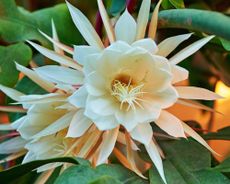Heirloom Turnip Plants - Growing Hinona Kabu Turnips


Turnips are important food sources in many regions. They were even made into Jack-o-lanterns by Irish school children and the source of a popular Grimm's fairy tale. Heirloom turnip plants help preserve that rich and interesting history of these root vegetables. Hinona Kabu turnips wouldn't make very good replacements for pumpkins, but their slender form makes them better suited for either raw or cooked recipes. Their origins are a subject of debate too, but they are still a popular Asian vegetable and found more and more in European and American kitchens.
Hinona Kabu Turnip History
Hinona Kabu turnips may have been cultivated as far back as the late 1400s. It is said that Lord Gamou Sadahid, the builder of the Otowa Castle in Japan, found the roots. However, it is more likely they are a cross of the European turnip, Long Red Tankard, which may have been introduced to Japan after the Meiji Restoration period of the 1800s. The name may be a reference to the town, Hino, in Shiga prefecture. These heirloom turnip plants are often made into pickles called cherry blossom pickles. The pale pink color and unique flavor made them a favorite and they were gifted to Emperor Kashiwabara who wrote a poem about the turnips. The attractive vegetables are long and slender, measuring 12 inches long (30 cm.) and about ½-inch wide (1.27 cm.). The roots have purple shoulders that fade into creamy white. The flavor is spicy with a sweet base. Even the dark green tops with purple veins are edible as a salad green or sautéed. The flavor of turnips is sweetest during the cool season of fall. In Japan, they are renowned for the pickles called Sakura Zuke. In commercial growing, they may be found as turnip of the sun or long turnip. In Japan, they are simply known as Kabu while in China they are Wujing or Manjing. In Cantonese, this translates to Mo Ching. In Asia, the leaves and roots are pickled in rice bran, nuka zuke or served with su dressing.
Growing Hinona Kabu Turnips
If you want to try your hand at growing Hinona Kabu turnips, sow seeds in spring or late summer for a fall harvest. Turnips prefer cooler temperatures and, in some regions, can be planted every two weeks for a continuous harvest of these Vitamin C rich goodies. They tolerate slightly alkaline soil but prefer a more acid base. One crucial element when planting turnips is well draining soil. As with any root crop, excess moisture can cause root rot. Cultivate the seed bed deeply and add plenty of nitrogen. You will get your first crop in just 40 to 50 days. Try them sliced and cooked with butter, soy sauce and a bit of sugar until caramelized. Delicious.
Gardening tips, videos, info and more delivered right to your inbox!
Sign up for the Gardening Know How newsletter today and receive a free download of our most popular eBook "How to Grow Delicious Tomatoes."
-
 7 Best Dwarf Tomato Plants
7 Best Dwarf Tomato PlantsHave a tiny growing space? Look for dwarf tomato seeds so you don’t miss out on summer’s juicy bounty.
By Susan Albert
-
 5 Night-Blooming Houseplants – Grow An Indoor Moon Garden
5 Night-Blooming Houseplants – Grow An Indoor Moon GardenThere is something uniquely special about night-blooming houseplants. Set the scene for a magical evening indoors with these fragrant flowering beauties.
By Amy Grant